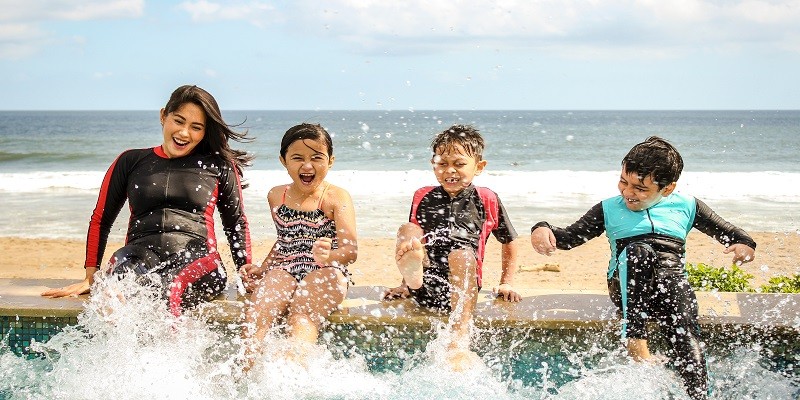Last Updated on June 29, 2023
Water safety is a paramount concern for every parent. We’ve all heard heart-wrenching stories about accidental drownings involving children. These tales are alarming and dreadful, but they also reflect an unfortunate reality. Accidental drownings happen more frequently than expected and can even happen to the most vigilant parents. It’s essential to address water hazards present at home and equip children with the necessary skills and tools to survive a life-threatening water situation.
Understanding the Risks
The National Drowning Prevention Alliance (NDPA) reports a disturbing 3,500-4,000 drowning deaths annually in the U.S., with approximately ten fatalities every day, excluding boating-related drownings. Tragically, drowning is the leading cause of unintentional injury-related death for children aged 1-4, affecting males and African Americans disproportionately. For every child who succumbs to drowning, five others receive emergency care for nonfatal submersion injuries. Therefore, many families with young children consider exploring local options like swimming lessons in Brisbane every year, known for their well-managed, high-quality programs.
Drowning can happen quickly, within 20-60 seconds, and silently, often occurring in environments perceived as safe. A chilling 23 percent of child drownings happen during family gatherings near a home swimming pool. Yet, other bodies of standing water, such as hot tubs, ponds, bathtubs, also pose a substantial risk of drowning. A child can drown in just 6 centimeters of shallow water, emphasizing the necessity of year-round water safety.
Preventive Measures Parents Should Take
1. Enrolling Your Child in Swimming Lessons Early
Amidst the COVID-19 pandemic, a concerning “drowning epidemic” has emerged, intensified by instructional pool closures and the increasing number of American families installing backyard pools. The American Academy of Pediatrics (AAP) recommends enrolling children in high-quality swim lessons by age one. Jessica Box, founder of the One Baby at a Time Foundation, which focuses on drowning prevention education, confirms that statistics show these lessons are effective.
At SoCal Survival Swimming, Box explains, “we offer high-quality swim lessons and children can begin as young as six months old. We teach them the swim-float-swim method, which gives them the power to survive in the water, establish good habits, and learn basic water safety skills.” The National Institute of Health reports that expert swim lessons decrease the risk of drowning in children by an impressive 88 percent!
With regards to COVID-19 precautions, swim schools are following rigorous protocols for student safety while imparting life-saving skills, such as contactless check-ins, routine screenings for staff and students, pool access to proper sanitation stations, use of Personal Protective Equipment (PPE) for staff members, and frequent pool chemical level checks. Moreover, the Centers for Disease Control and Prevention (CDC) have found no evidence of COVID-19 spreading through recreational water, and regular pool facility disinfection with chlorine and bromine usually deactivates the virus.
2. Safeguarding Your Home Pool
Protecting children in the pool means more than just life jackets or flotation devices; it’s also about securing the environment around the pool. Implementing safety measures like pool fences and alarms prevents accidental access. Pool alarms range from underwater motion detectors to wearable devices to fence alarms. Some even have Bluetooth connectivity!
Additionally, pool gates require diligent maintenance to provide an effective water barrier. The NDPA established a ‘Check Your Pool Gate Month’ and recommends a routine safety checklist for pool gates, which includes monitoring the foundation and latch and ensuring gates are self-closing and self-latching.
3. Assigning an Adult “Water Watcher”
Adult supervision is crucial, especially in settings without lifeguards. Designating a “Water Watcher” ensures someone is always monitoring the children. Water Watchers should be free of distractions, so they can focus solely on their responsibility, which includes preventing a child from going underwater unnoticed and providing immediate help when needed.
Understanding Dry Drowning
Dry drowning is a term that has caused considerable concern among parents. It refers to a scenario where a child appears normal after a day at the pool but starts struggling to breathe hours later. Two variants of this condition exist: dry drowning and secondary drowning.
Dry drowning happens when a person’s airway closes up due to a spasm caused by ingesting a small amount of water. The symptoms are not delayed and typically appear soon after leaving the water. Secondary drowning, on the other hand, occurs when water enters the lungs and leads to inflammation or swelling, causing respiratory distress that can take up to 24 hours to manifest.
Box clarifies that “drowning requires water, so the concept of ‘dry drowning’ is a myth. However, in certain situations, a child could inhale water before the airways clamp shut, leading to lung damage and breathing problems 6 to 12 hours later.” She recommends seeking immediate medical attention if your child ever struggles underwater and stops breathing.
In conclusion, understanding water safety and implementing preventive measures is crucial to protect our children from water-related accidents. While it is a significant responsibility, it is also an essential one. By taking the appropriate steps, parents can provide their children with the skills and knowledge they need to stay safe in and around water, ensuring peace of mind and promoting a fun, safe environment for everyone.

